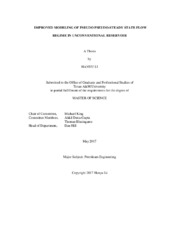| dc.description.abstract | Unconventional resources which are generally categorized by their extremely low permeability and high heterogeneity have become increasingly appealing over recent years. The typical development strategy is drilling horizontal wells with tight spacing hydraulic fractures. Such strategy leads to a significant loss of flowing area during fracture interference, thus resulting in a transition flow regime with unit slope identified as pseudo pseudo-steady state flow. Capturing such flow regime is critical in delivering accurate reservoir performance analysis. This thesis discusses a methodology to accurately capture drainage and pressure depletion behavior of horizontal wells with multiple hydraulic fractures. We will use asymptotic solution with separation of variables in order to model the pseudo pseudo-steady state flow regime. A more precise modeling of pressure behavior with analytical asymptotic solution ensures more confident reservoir forecast with low computation time.
Traditionally, we utilize two main methods to conduct unconventional reservoir calibration and forecast in order to obtain Estimated Ultimate Recovery (EUR). The first one is an analytical method such as decline curve analysis. It is a simplified empirical method which is time efficient however also ignores vital information such as complex geometries. The second method is by numerical simulation which takes into account of the geometries and heterogeneity, but is also time consuming especially when reservoir models contain millions of grid cells.
The Fast Marching Method emerges as a novel approach to calibrate and forecast reservoir performance with significantly reduced calculation time. The validity of this method has been tested in transient phase (infinite acting flow regime) of pressure diffusion. However, considering the vast existence of hydraulic fractured horizontal wells in unconventional reservoirs, adjacent fractures create virtual boundary conditions. Accordingly, the flow regime associated with hydraulic fractured horizontal wells is channel flow. Such flow regime is characterized by pressure front encountering boundary conditions in one direction while remain infinite acting in the perpendicular direction. Therefore we introduce the separation of variables in order to analyze pressure front propagation in these two directions independently. Such method optimizes the calculation of drainage volume in channel flow scenario, thus capable of modeling the signature feature of unconventional reservoirs, pseudo pseudo-steady state flow regime, more accurately. The results from this methodology is compared against the ones from numerical simulation as validation. | en |


